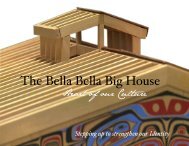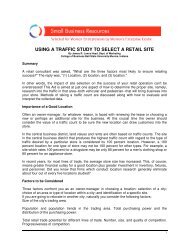Cascade NTFP Regional Profile.pdf - First Nations in British ...
Cascade NTFP Regional Profile.pdf - First Nations in British ...
Cascade NTFP Regional Profile.pdf - First Nations in British ...
Create successful ePaper yourself
Turn your PDF publications into a flip-book with our unique Google optimized e-Paper software.
<strong>Cascade</strong>s <strong>NTFP</strong> <strong>Profile</strong><br />
breath (Gypsophila paniculata) and sagebrush. Dur<strong>in</strong>g the autumn <strong>in</strong> the Fraser Canyon<br />
one may frequently see pickup trucks leav<strong>in</strong>g the mounta<strong>in</strong>s with large loads of cedar<br />
branches. The extent of the local floral greens <strong>in</strong>dustry is difficult to track as the District<br />
is so close to Vancouver allow<strong>in</strong>g <strong>in</strong>dividuals to travel to and from Vancouver as part of<br />
their work day.<br />
Unlike the East Kootenay where the wild cultured Christmas trees rema<strong>in</strong> an important<br />
<strong>in</strong>dustry (Keefer 2006), there is little activity <strong>in</strong> this region with wild trees. As previously<br />
described there is one Christmas tree tenure <strong>in</strong> the district. It is estimated that <strong>in</strong> a<br />
typical year harvest permits are given out for the harvest of approximately 1000 trees<br />
(Marlon Dosch pers. com 2007). These trees are harvested on rights of way, permits for<br />
trees of less than 3 m <strong>in</strong> height are worth $0.20 per tree.<br />
With<strong>in</strong> the District the harvest<strong>in</strong>g of conifer boughs is considered to be a m<strong>in</strong>or activity<br />
with low risk to the conifer plantations (Rob Jonas pers. com 2007). Accord<strong>in</strong>g to Jonas<br />
and Dosch (pers. com 2007) there have been no recorded <strong>in</strong>cidents of damage to the<br />
conifer stock from bough harvest<strong>in</strong>g activities; <strong>in</strong> fact the bough <strong>in</strong>dustry is regarded as<br />
beneficial.<br />
There are few requests for permits to harvest any type of floral greens. In the past (date<br />
uncerta<strong>in</strong>) one free-use permit was issued to a green harvester <strong>in</strong>terested <strong>in</strong> Oregon grape<br />
(Rob Jonas pers. com 2007).<br />
Native Plants for Horticulture and Restoration<br />
This sector <strong>in</strong>cludes native plant nurseries, native seed bus<strong>in</strong>esses, landscap<strong>in</strong>g<br />
companies that use native plants as well as the use of these plants for ecological<br />
restoration. Native conifer seeds and seedl<strong>in</strong>gs produced for reforestation efforts <strong>in</strong> the<br />
silviculture <strong>in</strong>dustry are not <strong>in</strong>cluded <strong>in</strong> this analysis.<br />
Due to the widespread death of p<strong>in</strong>e trees from the MPB epidemic there have been<br />
<strong>in</strong>creas<strong>in</strong>g requests for permits to transplant wild trees at the <strong>Cascade</strong> District office (Rob<br />
Jonan pers. com 2007). District staff members are currently work<strong>in</strong>g on draft<strong>in</strong>g<br />
language for a free-use permit that will allow the removal of trees for re-plant<strong>in</strong>g of<br />
mostly urban landscapes.<br />
Shackan Greenhouse<br />
The Shackan Greenhouse is a native plant nursery that was opened <strong>in</strong> response to<br />
concerns about the loss of fish habitat by the Nicola Tribal Association <strong>in</strong> partnership<br />
with the Shackan Band. The bus<strong>in</strong>ess has been open s<strong>in</strong>ce 1996 and employs 2 full time<br />
and a number of seasonal workers. Annually the bus<strong>in</strong>ess produces around 60,000<br />
seedl<strong>in</strong>gs that are primarily grown for reclamation and ecological restoration projects.<br />
This stock goes to projects <strong>in</strong>clud<strong>in</strong>g road deactivation, m<strong>in</strong>e reclamation, riparian<br />
revegetation and education. Though some seeds are purchased externally, most are<br />
collected locally by nursery staff. Species grown <strong>in</strong>clude: black cottonwood, trembl<strong>in</strong>g<br />
aspen, chokecherry, Saskatoon, red-osier dogwood (Cornus stolonifera) and many others.




